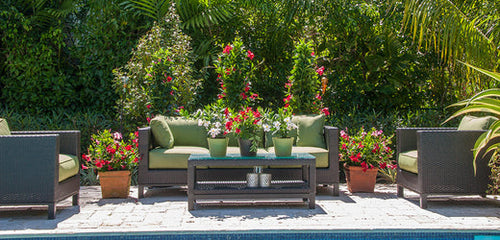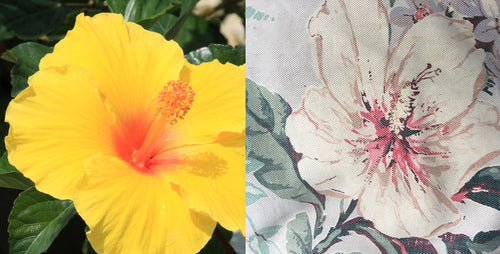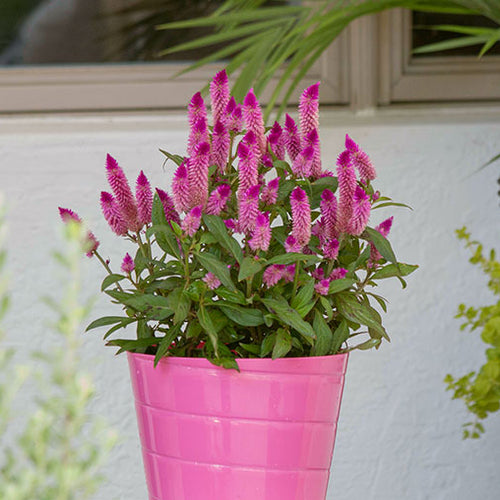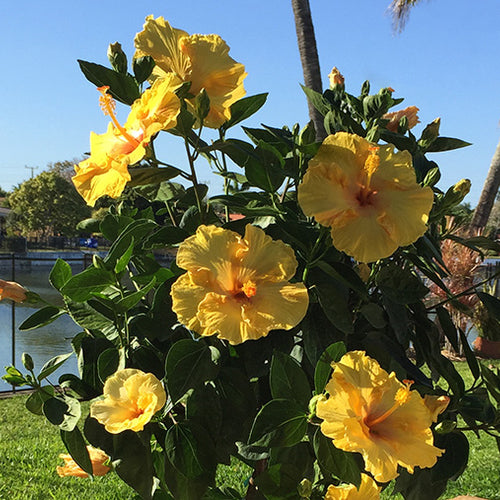Hibiscus add as much -- if not more -- tropical flair than any other plant. I love the way mine look around the edges of my back patio. Happily, hibiscus care is easy, too. You can enjoy their bold, beautiful blooms all summer long with these easy tips.
Be sure to give your tropical hibiscus lots of sun. In fact, the more direct sun they get, the better they'll bloom. At least 6 to 8 hours is optimal for prime flowering, but you can grow them in a little more shade (if you don't mind seeing fewer flowers over the summer). Afternoon sun is stronger than morning sun, so a spot that has shade in the morning and sun in the afternoon should yield more flowers than a spot that has sun in the morning and shade in the afternoon.
Splash on Some Water
Watering is the most common question we get when it comes to hibiscus care. In general, add moisture when the top inch or so of the potting mix is dry to the touch. It's best to water your hibiscus plants before the leaves start to wilt; once the plant starts to wilt, it's stressed -- and has less energy for flowering. A lot of folks ask us how much they should water their hibiscus. That's a tough question because frequency of watering depends on a variety of factors, including the size of the plant and the size of its pot, the type of potting mix it's growing in, how much sun it gets, and temperature. But you can't go wrong with the guideline of watering when the top inch of the potting mix or soil is dry.
Get the Soil Right
While we tend to focus on the parts of the plant that we can see, it's the root system that keeps everything running. So a key part of hibiscus care is making sure the roots are happy. Start with good soil. If you're growing a hibiscus in the ground (garden or landscape), that means a moist, well-drained soil that's rich in organic matter for best results. If you have soil that has a lot of sand or clay, add plenty of compost at planting time to optimize your hibiscus' growth.
If you're caring for your hibiscus in containers, then avoid garden soil. Instead, use a potting mix designed for use in containers. The product packaging should say "potting soil" or "potting mix" or "for container gardens." Most potting mixes are primarily made of peat or coir (recycled coconut husks), which holds water well, but still allows for the roots to breathe. Other soil amendments help improve the potting mix. One common amendment is perlite, the little white pieces of puffed rock that help add air to the mix.
Fertilize Like a Pro
Ever wonder how much to fertilize your plant? That's another common hibiscus care question we receive. Again, it depends, but this time the type of fertilizer you use matters. Timed- or slow-release fertilizers are easiest; you simply use them at the beginning of the season when you plant and they contribute small amounts of nutrients throughout the growing season. The effect is just like giving your plants regular snacks, keeping them well-fed and happy.
The other type of fertilizer delivers nutrients all at once, like hitting a buffet restaurant and is typically mixed with water. How often you use a water-soluble fertilizer like this depends on the brand and formulation. Always read and follow the directions on the product packaging to avoid issues with over fertilization.
Learn more about fertilizing.
Use these hibiscus care tips and you can enjoy gorgeous, colorful hibiscus in your favorite outdoor spaces!
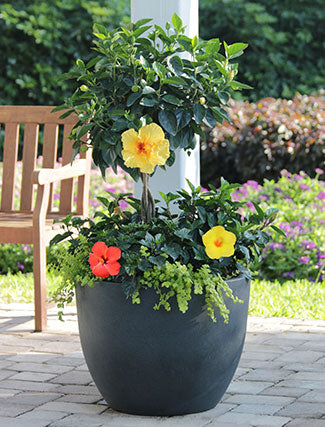 Start with Sun
Start with Sun
Be sure to give your tropical hibiscus lots of sun. In fact, the more direct sun they get, the better they'll bloom. At least 6 to 8 hours is optimal for prime flowering, but you can grow them in a little more shade (if you don't mind seeing fewer flowers over the summer). Afternoon sun is stronger than morning sun, so a spot that has shade in the morning and sun in the afternoon should yield more flowers than a spot that has sun in the morning and shade in the afternoon. Splash on Some Water
Watering is the most common question we get when it comes to hibiscus care. In general, add moisture when the top inch or so of the potting mix is dry to the touch. It's best to water your hibiscus plants before the leaves start to wilt; once the plant starts to wilt, it's stressed -- and has less energy for flowering. A lot of folks ask us how much they should water their hibiscus. That's a tough question because frequency of watering depends on a variety of factors, including the size of the plant and the size of its pot, the type of potting mix it's growing in, how much sun it gets, and temperature. But you can't go wrong with the guideline of watering when the top inch of the potting mix or soil is dry. Get the Soil Right
While we tend to focus on the parts of the plant that we can see, it's the root system that keeps everything running. So a key part of hibiscus care is making sure the roots are happy. Start with good soil. If you're growing a hibiscus in the ground (garden or landscape), that means a moist, well-drained soil that's rich in organic matter for best results. If you have soil that has a lot of sand or clay, add plenty of compost at planting time to optimize your hibiscus' growth.If you're caring for your hibiscus in containers, then avoid garden soil. Instead, use a potting mix designed for use in containers. The product packaging should say "potting soil" or "potting mix" or "for container gardens." Most potting mixes are primarily made of peat or coir (recycled coconut husks), which holds water well, but still allows for the roots to breathe. Other soil amendments help improve the potting mix. One common amendment is perlite, the little white pieces of puffed rock that help add air to the mix.
Fertilize Like a Pro
Ever wonder how much to fertilize your plant? That's another common hibiscus care question we receive. Again, it depends, but this time the type of fertilizer you use matters. Timed- or slow-release fertilizers are easiest; you simply use them at the beginning of the season when you plant and they contribute small amounts of nutrients throughout the growing season. The effect is just like giving your plants regular snacks, keeping them well-fed and happy. The other type of fertilizer delivers nutrients all at once, like hitting a buffet restaurant and is typically mixed with water. How often you use a water-soluble fertilizer like this depends on the brand and formulation. Always read and follow the directions on the product packaging to avoid issues with over fertilization.
Learn more about fertilizing.
Use these hibiscus care tips and you can enjoy gorgeous, colorful hibiscus in your favorite outdoor spaces!
Written by Justin Hancock





